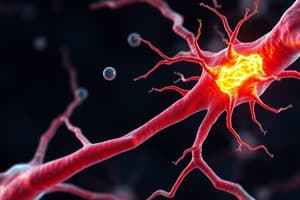Podcast
Questions and Answers
Which type of summation occurs when a neuron sends repeated EPSPs over time?
Which type of summation occurs when a neuron sends repeated EPSPs over time?
- Temporal summation (correct)
- Spatial summation
- Both temporal and spatial summation
- None of the above
What is the main way neurons communicate?
What is the main way neurons communicate?
- Electrical communication
- Chemical communication (correct)
- Both electrical and chemical communication
- None of the above
What triggers the release of neurotransmitters into the synaptic cleft?
What triggers the release of neurotransmitters into the synaptic cleft?
- Chloride influx
- Sodium influx
- Potassium influx
- Calcium influx (correct)
What is the main function of reuptake proteins?
What is the main function of reuptake proteins?
What happens when the membrane potential increases above the excitability threshold?
What happens when the membrane potential increases above the excitability threshold?
Which of the following is true about the resting membrane potential of a neuron?
Which of the following is true about the resting membrane potential of a neuron?
What is the purpose of the refractory period in a neuron?
What is the purpose of the refractory period in a neuron?
Which of the following is true about myelinated neurons?
Which of the following is true about myelinated neurons?
What is the function of oligodendrocytes in the brain?
What is the function of oligodendrocytes in the brain?
What is the study of how neurons communicate with each other to generate an action potential called?
What is the study of how neurons communicate with each other to generate an action potential called?
Which process is responsible for clearing unbound neurotransmitters from the synapse?
Which process is responsible for clearing unbound neurotransmitters from the synapse?
What type of receptors are ligand-gated ion channels composed of subunits with orthosteric sites for neurotransmitter binding?
What type of receptors are ligand-gated ion channels composed of subunits with orthosteric sites for neurotransmitter binding?
Which disorders are linked to mutations in genes encoding postsynaptic density proteins?
Which disorders are linked to mutations in genes encoding postsynaptic density proteins?
What type of receptors are connected to G proteins and can also be ion channels?
What type of receptors are connected to G proteins and can also be ion channels?
What is the role of ion channels in neurotransmission?
What is the role of ion channels in neurotransmission?
Flashcards are hidden until you start studying
Study Notes
Neurotransmitter Release, Receptors, and Effects
- Neurotransmitters are released through exocytosis upon an action potential.
- Unbound neurotransmitters are cleared from the synapse through endocytosis or transporters.
- Synaptic cleft contains neurotransmitters, which bind to receptors in the postsynaptic density.
- Mutations in genes encoding postsynaptic density proteins are linked to disorders like schizophrenia, autism, and learning disabilities.
- Neuropharmacology studies receptor systems, including ionotropic and metabotropic receptors.
- Ionotropic receptors are ligand-gated ion channels composed of subunits with orthosteric sites for neurotransmitter binding.
- Metabotropic receptors are connected to G proteins and can also be ion channels.
- Neurotransmitters are synthesized in the presynaptic terminal and transported to the synaptic cleft.
- Enzymes metabolize neurotransmitters in the presynaptic terminal.
- Ion channels allow ions to enter or exit the neuron, and their binding to neurotransmitters causes depolarization or inhibition.
- Metabotropic receptors bind to G proteins and trigger downstream effects, including activation of ion channels or second messenger systems.
- Multiple second messenger systems exist, and they can activate enzymes, regulate neuron response to neurotransmitters, and cause release of calcium from the cell.
Studying That Suits You
Use AI to generate personalized quizzes and flashcards to suit your learning preferences.




